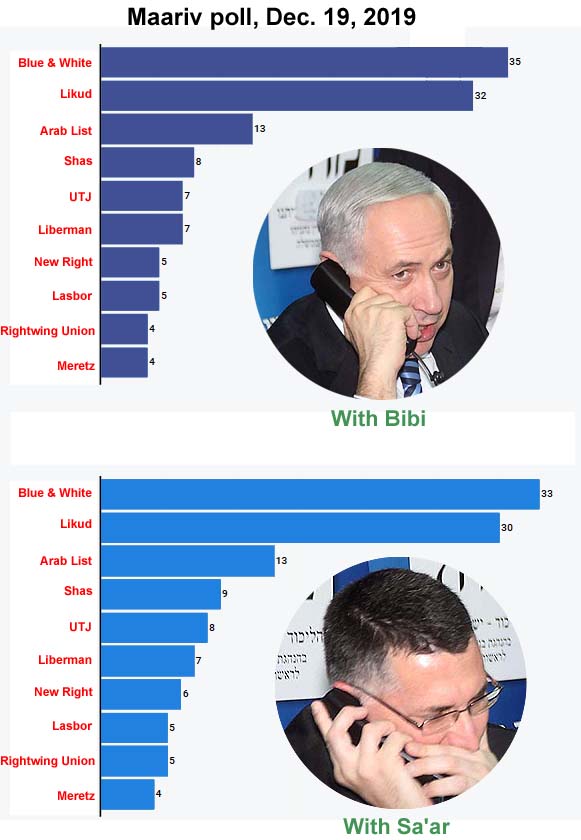Photo Credit: Gideon Markowicz/ Flash90

A Makor Rishon survey shows that had the election been held on Thursday this week, Blue&White would have climbed to 38 seats (from 33), while the Likud with Benjamin Netanyahu at the helm would rise to 34 (from 32), and Liberman would have gone down to 7 from his current 8 seats. Bennett and Shaked’s New Right party would get 7 seats, while Habayit Hayehudi would disappear below the 3.25% threshold vote.
Despite Likud’s modest gain and Blue&White’s more impressive rise, neither party would be in position to forge a government, with the rightwing bloc stuck at 56 mandates, and the center-left bloc with the Joint Arab List’s support reaching only 57.
‘);
_avp.push({ tagid: article_top_ad_tagid, alias: ‘/’, type: ‘banner’, zid: ThisAdID, pid: 16, onscroll: 0 });
But should Gideon Sa’ar make it to the top the Likud party come the December 26 primaries, Likud would only get 30 seats (2 fewer than today), but the rightwing bloc would go up to 60 seats, with New Right getting 10 seats and Habayit Hayehudi squeezing above the threshold with 4 seats.
In the same scenario, Blue&White receives only 34 seats, with the gap between the two big parties remaining the same: 34 – 30.

In both versions of the Makor Rishon poll, the Joint Arab List goes up from 13 to 14 seats and Liberman’s Israel Beiteinu stays at 7. Both results could be rooted in the poll’s methodology. Conducted by Menachem Lazar of the Panels research group, the survey included 1,001 respondents, of whom 851 were Jewish and 150 non-Jewish (which in Israel mostly means Arabs and Russians). The survey’s margin of error is surprisingly low: +-3.4%.
A survey conducted on the same Thursday by the Smith Institute under the management of Rafi Smith for Maariv and 103 FM Radio, reveals very similar results:
With Netanyahu at the top, the Likud receives more seats than under Gideon Sa’ar, but the rightwing bloc gets more mandates altogether with Saar than with Netanyahu.
With Netanyahu at the head of Likud, Blue&White gets 35, Likud 32, Joint Arab List 13, Shas 8, United Torah Judaism 7, Liberman 7, New Right 5, Habayit Hayehudi (with Otzma Yehudit) 4, Labor 5, Meretz 4.
But if Saar is at the head of Likud, Blue&White gets 33, Likud 30, Joint Arab List 13, Shas 9, United Torah Judaism 7, New Right 8, Liberman 6, Habayit Hayehudi (with Otzma Yehudit) 5, Labor 5 and Meretz 4.
So that the rightwing bloc with Netanyahu gets 3 mandates fewer than with Sa’ar – 56 vs. 59 seats respectively.
And the left-center bloc supported by Joint Arab List gets 57 seats with Netanyahu, but only 55 seats without him.
This suggests that there is a hefty chunk of center-right voters who are allergic to Netanyahu, and would prefer a bloc led by Gantz. But once Netanyahu is taken out of the equation, the same chunk of voters returns to the right – not to the Likud, mind you, but to the two Zionist parties to the right of Likud. At the same time, a chunk of Likud voters are allergic to Sa’ar, and prefer the same two Zionist parties over him.
This is an extremely volatile ballgame at this point, considering the stalemate of the past two elections. But one thing is certain: running together, Bennett, Shaked, Smotrich and Ben-Gvir could bring home as many as 13 mandates, better than their great win in 2013, which yielded 12 seats.
‘);
_avp.push({ tagid: article_top_ad_tagid, alias: ‘/’, type: ‘banner’, zid: ThisAdID, pid: 16, onscroll: 10 });



